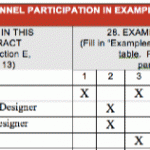
The idea of marketing people reviewing price proposals is crazy, right?
Yet, inevitably, a price proposal will find its way to your desk. Do you just assume it is perfect? Or is there some value you can add to the process?
I’m going to explain how you can review cost proposals, even if you don’t know how to perform the work that’s being estimated. I’m also going to describe why I feel you can provide significant value to the process.
But first, let’s talk in general about price estimates.
An estimate is an educated guess. Let’s say I asked you to estimate how long it would take you to walk an entire block in your neighborhood. You’ve probably walked down an entire block many times. So, how long would that take?
There are a couple ways you could come up with that number.
Gut Estimate
You could make a wild guess (i.e. go with your gut). A good guess might be 7 minutes. 10 minutes seems like too long. 5 minutes seems too short.
The problem with this approach is it is completely baseless. Our gut is often wrong when it comes to time estimates. This is known as the “planning fallacy”.
Relative Estimate
Another way you could do it is to make your conclusion based on a fact you know. For example, you know it takes you 15 minutes to walk to the train station which is 3 blocks away. So, now we’re going to say it takes 5 minutes to walk one block.
The problem with this approach is you have to make assumptions. For example, we are assuming that all three blocks are the full length. But maybe the train station is in the middle of the last block. We’re assuming the conditions we are walking in are the same (It’s not snowing or raining, etc.).
However, the relative approach is going to be better than your gut. It’s based on something we have measured and know to be true.
Industry Statistics
In this approach, you use industry averages. So, you’d say that the average person walks 3 miles per hour (264 feet per minute). Let’s say we find out that the average block is 800 feet. So, the average person would walk the average block in 3.03 minutes.
This is very common approach to estimating in a few industries. The problem is it assumes your task is representative of the average AND your ability to complete that task is average.
That could be a risky bet to make.
Historical Data Approach
The last approach would be to use your own historical data. Let’s say you happen to keep track of how long it takes you to walk each block as you stroll down the street. Then you use historical data from comparable blocks to estimate how long it would take you.
You could also go a step further and run what’s known as a Monte Carlo simulation with this data to determine an even more probable estimate.
Using historical data is absolutely, positively, the best way to estimate. But here is the unspoken truth about price proposals. Very few people use historical data to come up with an estimate. Many, many people, use the first approach…their “gut.”
Many firms, despite capturing this information in their accounting systems, don’t make it easily available to use in estimates.
The argument you might hear against using historical data is that, “every project is different.” While there is a degree truth to that, we also know that gut estimates are deeply flawed.
Logic Flaws
Reviewing price proposals is a bit different from creating them. Reviewing price proposals is all about logic. What you are looking for are possible flaws in logic.
Let’s say the RFP prescribes three on-site meetings. Yet, you notice that your estimate does not include time for meetings. This is a potential flaw in logic that either someone has to explain or needs to be corrected.
How about if your subconsultant has estimated 100 hours, but then $1,500 for milage. You can simply calculate that, at 54 cents per mile, a person can drive 2,777 miles. At 60 miles per hour, that will take you 46 hours. Now, do they plan to spend almost half the time in the car? Or are they not charging for travel time? This is a question that needs to be asked.
Here’s another scenario. Your firm estimates to construct a building for $50/square foot. But you know the industry average is $150/square foot. Why do they think they can build it for a third of the industry average? Maybe they have a reasonable explanation. Maybe they don’t.
What if they estimate that 300 admin hours will be needed during the course of this contract. But you’ve had the contract before and can see that they’ve never used more than 50 admin hours. Why are they estimating 300 now? Has something changed?
Here is another scenario. You know the client has a budget of $100,000. Your estimate is $105,000. That’s another type of logic flaw. Is $105,000 your absolute best price? It’s illogical to assume a client can snap their hands and $5,000 will appear.
There could also be issues with what is not said in the RFP. What if it doesn’t ask for any meetings. You don’t even need a college degree to realize any project will require at least one meeting. Are there meetings in your price? Did you define how many?
How The Estimating Approaches I Described Fit Into This
You’ll need all of the approaches I talked about to identify logic flaws in estimates. You’ll need your gut. You’ll need to compare it to other estimates you’ve seen. You may need to consider industry averages. And, if you can, you should look at historical data.
Your job, as someone reviewing the estimate, is not to tell them what the price should be. It is to identify flaws in logic. It’s to ask questions, listen to the answers, and then identify any logic flaws in the answer.
That’s not only how, but why marketers should review price proposals.
Now it’s your turn. Do you think marketing people should review price estimates for technical work? Leave a comment below.





Great article, Matt. I like not to limit my skill set because I am not the one performing the work and I think it is good practice for marketing and business development staff to have a baseline knowledge of the cost and timeline associated with certain types of projects. This allows us to add value and a logical filter to a cost submission to make sure it is in line with industry standards.
Meghan,
Thanks for the comment!
While I’m not sure marketing folks SHOULD review price proposals, I don’t know of any reason why they SHOULDN’T. With an hour’s training, they can certainly understand and implement the logic you speak of here. By the way, in my 35+ years in the A/E industry, I have heard of one other method of estimating, wherein firms price by the plan sheet and try to predict how many sheets the plan set will require. Ultimately, this is probably a combination of most or all the methods you have described.
Good point, Bernie. Thanks.
More often than not, I find math errors in price proposals.
I always have people check my spreadsheets, because I tend to screw them up. I always say triple check the math.
To expand on Bernie’s comment–at our firm, if we can’t get the other information that we need to provide a cost proposal (i.e., project budget, size of project, etc.), my technical folks will ask for an estimated number of drawings, and they can produce a fee proposal based on that. It is definitely not their first choice, but it works in a pinch.
Now I want to argue a bit with Bernie–I think there is one very good reason for marketers to review price proposals. One of the things that marketers become VERY good at is noticing details–making sure that we meet all of the RFP requirements, etc. I frequently find typos or other mistakes on documents that multiple people have checked–and it’s just because I practice that skill more than most people. This makes us particularly well suited for doing a logic check like Matt suggests.
One more related thought–in my current position, whenever we need to provide a fee proposal for a complex project, I create a scope breakdown, where I create an outline of the project scope in an Excel spreadsheet. My team then uses this outline to help them assign hours/fees to each of the project elements will require work from our team members. It is a task that I dread, because it is pretty boring to do, but I have found that it really helps me do a better job of personalizing our resumes, experience, approach because it means I catch more of the subtle details of the scope, and highlight those similarities in our response. In addition, it also gives me the opportunity to flag issues with the scope (like missing meetings) for the technical folks to be aware of when they are creating the fee proposal.
Last but not least–I ALWAYS check the math. I work for a firm that specializes in estimating, and they are geniuses at using formulas in Excel to ensure that the arithmetic is correct. But every once in a while, they will miss adding a cell to the formula, or a number will be input incorrectly, and again, the marketing person’s proofreading eye has come in handy more than once for catching this type of mistake.
We are rather multiplier (and profit) sensitive. All our price proposals over $100k are subject to review by a strong partner on the technical side to make sure we’re covering our bases and ensuring ourselves enough budget to do the job and make money doing it. A few ways we’ve found Marketeers can help with price proposal review: 1) checking math on spreadsheets (as mentioned above), 2) reminding technical staff about overhead costs (or marketing staff time to help with QC of the final project deliverables or graphic design support, etc.), 3) reminding staff about escalation if the project or contract duration exceeds a year, and 4) starting the discussion about pricing strategy many days in advance of the proposal going out the door (not waiting until the last minute).
It is never a bad idea to have an extra set of “unbiased” eyes look over the bid proposal before submittal, as long as the expectations are clear. I would expect our marketing staff to provide a logic review, to review accuracy and check for errors, and to make sure the proposal/bid is clear to our audience. On past responses, I have worked with our marketing and accounts staff to obtain historical price information, as mentioned in your article. I would expect our technical staff to provide a more in-depth review of the basis of the price.